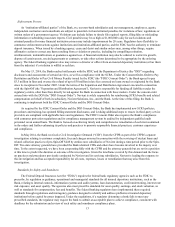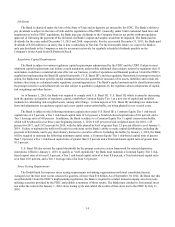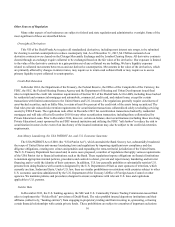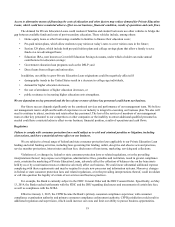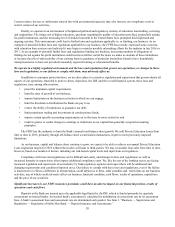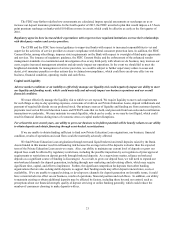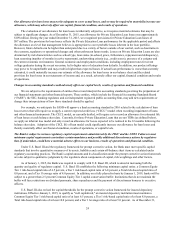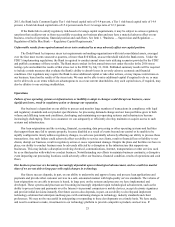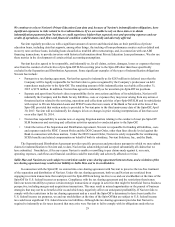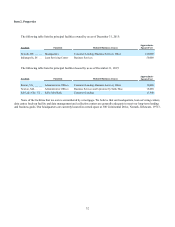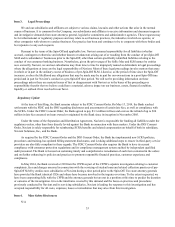Sallie Mae 2015 Annual Report Download - page 25
Download and view the complete annual report
Please find page 25 of the 2015 Sallie Mae annual report below. You can navigate through the pages in the report by either clicking on the pages listed below, or by using the keyword search tool below to find specific information within the annual report.23
capital market dislocations or other factors not within our control. In these circumstances, our earnings could be materially
adversely affected.
We are also subject to risks associated with changes in repayment and prepayment rates on Private Education Loans. For
example, most of our Smart Option Student Loan products promote accelerated repayment. In addition, increases in
employment levels, wages, family income or alternative sources of financing may also contribute to higher than expected
prepayment rates, which can adversely affect our financial condition.
Our use of derivatives to manage interest rate sensitivity exposes us to credit and market risk that could have a material
adverse effect on our earnings.
We maintain an overall interest rate strategy that uses derivatives to reduce the economic effect of interest rate changes.
Developing an effective hedging strategy for dealing with movements in interest rates is complex, and no strategy can
completely avoid the risks associated with these fluctuations. For example, our education loan portfolios remain subject to
prepayment risk that could cause them to be under- or over-hedged, which could result in material losses. In addition, our
interest rate risk management activities expose us to mark-to-market losses if interest rates move in a materially different way
than was expected when we entered into the related derivative contracts. As a result, there can be no assurance hedging
activities using derivatives will effectively manage our interest rate sensitivity, have the desired beneficial impact on our results
of operations or financial condition or not adversely impact our liquidity and earnings.
Our use of derivatives also exposes us to market risk and credit risk. Market risk is the chance of financial loss resulting
from changes in interest rates and market liquidity. Some of the swaps we use to economically hedge interest rate risk between
our assets and liabilities do not qualify for hedge accounting treatment. Therefore, the change in fair value, called the “mark-to-
market,” of the swaps that do not so qualify is included in our statement of income. A decline in the fair value of those
derivatives could have a material adverse effect on our reported earnings.
We are also subject to the creditworthiness of third-parties, including counterparties to derivative transactions. For
example, we have exposure to the financial conditions of various lending, investment and derivative counterparties. If a
counterparty fails to perform its obligations, we could, depending on the type of counterparty arrangement, experience a loss of
liquidity or an economic loss. In addition, if a derivative counterparty fails to perform, we might not be able to cost effectively
replace the derivative position depending on the type of derivative and the current economic environment, and thus could be
exposed to a greater level of interest rate risk, potentially leading to additional losses. Our counterparty exposure is more fully
discussed in Part II, Item 7. “Management’s Discussion and Analysis of Financial Condition and Results of Operations -
Liquidity and Capital Resources - Counterparty Exposure.” If our counterparties are unable to perform their obligations, such
inability could have a material adverse impact on our business, financial condition, results of operations and cash flows.
Defaults on education loans, particularly Private Education Loans, could adversely affect our business, financial position,
results of operations and cash flows.
We bear the full credit exposure on Private Education Loans. Delinquencies are an important indicator of the potential
future credit performance for Private Education Loans. Our delinquencies, as a percentage of Private Education Loans in
repayment, were 2.2 percent at December 31, 2015.
In connection with the Spin-Off, we conformed our policy with the Bank’s policy to charge off loans after 120 days of
delinquency. We also changed our loss emergence period - management’s estimate of the expected period of time between the
first occurrence of an event likely to cause a loss on a loan (e.g., a borrower’s loss of job, divorce, death, etc.) and the date the
loan is expected to be charged off - from two years to one year to reflect both the shorter charge-off policy and related servicing
practices. Prior to the Spin-Off, the Bank sold all loans past 90 days delinquent to an entity that is now a subsidiary of Navient.
Post-Spin-Off, sales of delinquent loans to Navient have been significantly curtailed. Similarly, pre-Spin-Off SLM’s Private
Education Loan default aversion strategies were focused on the final stages of delinquency, from 150 days to 212 days. As a
result of changing our corporate charge-off policy to charging off at 120 days delinquent and greatly reducing the number of
potentially delinquent loans we sell to Navient, our default aversion strategies now focus more on loans 30 to 120 days
delinquent. We only have one and one half years of experience in executing our default aversion strategies on such compressed
collection timeframes. If we are unable to maintain or improve on our existing default aversion levels during these shortened
collection timeframes, default rates on our Private Education Loans could increase.


